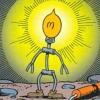|
|
Pressure Relief At Heat Exchanger Shell And Tube For Fire Case
#1

Posted 20 August 2012 - 11:44 AM
Both tube and shell are liquid full (water and oil). My concern is that I am getting huge valve orifices if I assume that vapour generation will displace an equal volume of liquid. Also, I don't know what to assume about heat flux from fire into the tubes (as they are behind a shell).
How do I go about calculating the relief load for fire for this shell and also for the tubes? I am doing basic engineering and do not need to dive into so much detail at this point.
#2

Posted 20 August 2012 - 02:39 PM
it really does concern me , as i assume it does many other "seasoned " engineers, that you and many liek you have to post questions regarding safety valve sizing and general relief and blowdown philosphy on this website.
I cannot undersatnd how companies give tasks in this very imprtant area of process engineering to young engineers with absolutely no experience.
May i suggets to you, and all in a simlar position as you , that you go back to your supervisors and ask them to explain correct practices and methodogies to you.This board is not really designed to teach the basics of Flare and Relief system design to young engineers.
I have learnt over the past 30 years in this filed by reading API, Norsok and many other manuals/design guides in this field . The power of the internet is now such that you can do your own research very quickly rather than just post "help me i know nothing " messages here .
flar e nuf
#3

Posted 20 August 2012 - 03:17 PM
You should learn some grammar first. Use the internet for that.
It is perfectly fine to gather information on methods on any technical forum at the initial stages of a project. And "inexperienced" engineers can be placed on any assignment as long as their work will be reviewed in detail down the road by others in drawing review, HAZOP, etc.
I may have the proposed solution, and checked all standards, but I would like to see what others think of the same issue, and maybe I am even not discussing the solution I think of to not lead anyone on this forum to it. That is part of what is called peer review. And this is the spirit of this forum. An engineer that thinks that he/she is a know/it/all has stopped learning and taking input from others. You shouldn't stop learning after 30 years of practice.
By the way API does not cover this question in any detail, it is a fair, relevant and interesting question, even if it is only for junior engineers. One day, you were a junior engineer.
I am glad to know that most people on this Forum will not share your point of view, which assumes many wrong things about me and my post.
dtmgo1
#4

Posted 21 August 2012 - 12:00 AM
there is too much arrogance in your post.... This will inhibit a lot of members to give you some help... and, believe flarenuf, you'll need a lot of help.
cheers
#5

Posted 21 August 2012 - 04:29 AM
Seems you need general guidelines in order to calculate the relief load due to fire case in S&T heat exchangers. If so, you can find them as follows, otherwise you shall specify your query to get the needed response:
Shell side protection against fire case:
- Wetted wall area should be calculated based on normal volume fraction of the liquid in the shell side.
- Relief load calculation should be done same as what to be calculated for vessels/drums.
- In the cases will result in huge orifice area due to sudden overpressure, let say e.g. pressure spike, one can use rupture disk instead PSV to cope with the relevant catastrophic conditions.
Tube side protection against fire case:
- Fire case heat rate could be transferred to tube fluid under relieving conditions.
- Fire case heat rate into tube side fluid should be considered when the bubble point of the tube side fluid at relevant MAWP is less than the bubble point of the shell side fluid at relieving pressure.
Fallah
#6

Posted 21 August 2012 - 06:04 AM
On the other hand I disagree to "maybe I am even not discussing the solution I think of to not lead anyone on this forum to it. That is part of what is called peer review. And this is the spirit of this forum " (post No 3). Results and documentation should be disclosed and assessment requested. Besides another may spend much labor to no avail. However post No 1 indicates that this procedure has not been applied, since results are mentioned ("getting huge valve orifices").
Comment on grammar, probably a product of hot mood, should not have been written.
I hope of understanding above stand. Others' opinions would be constructive, but this is very seldom for such matters.
#7

Posted 21 August 2012 - 10:12 AM
In such cases, there's no problem with answering the posted question, but this is a safety-critical field - not one for amateurs. An engineer's sense of ethical conduct obligates him/her to point this out to such questioners.
#8

Posted 21 August 2012 - 01:23 PM
On another topic: Imagine the progress and creativity in research and development if preliminary results and developing ideas where shared among competing R&D firms? They would end up thinking about the same things. People are creative when they are forced to think of the problem, not of the "solution". If I figure out good answers, I will post my general ideas and methods, but the time for that is not now. Science grows through sharing knowledge, but knowledge is shared when its ready to be shared (e.g. published). People don't publish draft articles.
Again, to all readers, note that in this case the assumption in this case is that the heat exchangers can be blocked while there is a fire incident (therefore a PR valve is required). This is usually not the case for the risk of a fire case. In general, administrative procedures should be in place to have drained and depressurized the exchangers before blocking them (this is a must if they do not have PR valve). Caution signs are recommended at the block valves of all exchangers that can be isolated.
Pressure relief design is a safety issue, and just as any important application of engineering principles, its design should be reviewed by experienced/qualified engineers. I know that my post may seem to be that of a beginner to the untrained eye, but OBVIOUSLY I would never practice real safety design without guidance and detailed review from a more experienced engineer.
Edited by dtmgo1, 21 August 2012 - 02:42 PM.
#9

Posted 22 August 2012 - 06:15 AM
1. "I am surprised by the attention here given to issues outside the technical scope of my question....Why do some people here think they can police engineering ethics in this kind of forum?"
Look into your post No 3 (many points lost because of it) and the comments arisen as a reaction. Ethics would suggest (α) looking into them calmly and give any response accordingly (β) not give negative feedbacks to whatever is not liked (you have placed four so far).
Forum is free enough not to exclude such comments, I hope, promoting technical matters in the long term. Such issues can be even more significant than technical in our careers.
2. "Imagine the progress and creativity in research and development if preliminary results and developing ideas where shared among competing R&D firms? They would end up thinking about the same things. People are creative when they are forced to think of the problem, not of the "solution". If I figure out good answers, I will post my general ideas and methods, but the time for that is not now."
This point has been treated in post No 6 by kkala. You do not ask help from a competitor. A volunteer is in the same vehicle, apparently needing all your drafts and efforts for effective help. Do not cause more spending of his/her labor by hiding something. If you employed engineers, you could do it (probably with problems). But think here that extra labor could be devoted to others' queries. Straightly ask for what you want, stating your conditions and thoughts,
Neverteless you have not actually followed mentioned process of hiding, as post No 1 indicates (though you could have been more specific).
@all readers
1. With negative feedbacks in the plurality of the posts, situation has been rather complex. I believe it is better to avoid placing negative feedbacks for some time (not to give the impression of retaliation), waiting for Forum competent persons to act (Administrators, etc) Their opinions would be also of interest.
2. Some posts advise that a number of engineers have to improve their skillfulness / knowlege on safety issues / PRVs. Stopping sending relevant querries will not improve them. Articles devoted to the issue and based on actual queries could. Can Cheresources prepare a series of introductory articles about e.g. PSVs and related scenaria (fire, blocked outlet, etc)? Not all details, just basic understanding to be able to access more detailed practices / standards. The work is not so easy, even if a big part of it can be found in past articles. I was impressed in the past by some publications by Phil Leckner.
Edited by kkala, 22 August 2012 - 06:31 AM.
#10

Posted 22 August 2012 - 01:09 PM
Engineers are many things, and one of them is peers, but they are also competitors. Everybody knows that in the real world, knowledge does not flow freely between engineers, not even from volunteers. My problem statement is complete, relevant and interesting, in particular for the tube side load calculation.
If I wanted to dive into details and methods, I would search for technical literature (published articles).
“If you can't explain it to a six year old, you don't understand it yourself.”- Albert Einstein
#11

Posted 23 August 2012 - 07:30 AM
#12

Posted 23 August 2012 - 08:33 AM
Kostas Kalaitzoglou
#13

Posted 23 August 2012 - 01:31 PM
That specific topic was directly addressed by Fallaha in post #5 in a detailed manner.
If there are other issues or topics, they should be posted in another thread.
#14

Posted 24 August 2012 - 10:44 AM
Relief situation is really interesting. I would estimate relief load as below:
Assumption is that both shell and tubeside are blocked during fire.
1) Based on wetted area, calculate heat input to exchanger.
2) Shellside relief rate:
Heat input by fire into shellside should be split into two components:
- Heat transferred to tube (say Qtube)
- PSV lifting and relieving shellside fluid with mass relief rate = (Qrelief-Qtube)/latent heat
Heat transfered to tube can be estimated as below:
- Get heat transfer area for exchanger
- Estimate heat transfer coefficient (would be natural convection initially, but boiling may take place on both sides few minutes into fire, natural convection stage would govern shellside PSV and boiling stage would govern tubeside PSV).
- Estimate LMTD based on initial temperatures (or some estimate of temperature profile) for natural convection stage or boiling temperatures at PSV set pressure for boiling stage.
3) Tubeside relief rate:
Heat input to tube is heat gained from fire by front and rear heads and heat transferred by shell.
Relief rate = (Qtube+Qfirechannel) / latent heat
Regards,
Sachin
#15

Posted 24 August 2012 - 10:49 AM
Post No 2 expresses a stand, harsly but clearly.
Response by post No3 has triggered reactions expressed in posts No 4, 6, 7, 9, while OP responded in posts No 8, 10.
All emerged critical issues are apparent (and judged clear) in the posts reported in the above sentence. They deserve consideration, not bypass for a formal reason. A clear stand would be useful, if this is possible.
Technical response to the issue under title was given in post No 5 and post No 14.
Members (offering free services) are hopefully free to express a stand not related to title, if the thread development fits it well.
Besides present issues can be hardly transfered to a new thread.
Edited by kkala, 24 August 2012 - 11:14 AM.
#16

Posted 26 August 2012 - 03:25 PM
Can Cheresources prepare a series of introductory articles about e.g. PSVs and related scenaria (fire, blocked outlet, etc)? Not all details, just basic understanding to be able to access more detailed practices / standards. The work is not so easy, even if a big part of it can be found in past articles. I was impressed in the past by some publications by Phil Leckner
For instance, look at Phil Leckner's "Relief valves: what can go wrong scenarios Part 1" in http://www.cheresour...cenarios-part-1 '> http://www.cheresour...cenarios-part-1 (part 2 has not been found). Useful to study for the principles pointed out, though not an introductory text. Taken from http://www.cheresour...rticles/safety/ '> http://www.cheresour...rticles/safety/ .
#17

Posted 28 August 2012 - 12:18 PM
As per Admins, I stick to the technical side of this topic.
Depending on the location of the tube side PR valve, vapour generated could displace liquid, causing a liquid load to reach the PR valve inlet. So the PR valves should be located at a high point. The manufacturer should be involved in the design, and PR valves designed for vapour relief should be placed in the correct locations. The tube relief path is more elaborate than the shell relief path.
I have reviewed some information on how to calculate latent heat of vaporization for multi component systems. There is not a clear consensus about the method to be used. Some use a conservative 50 BTU/lbm but this may result in an oversized PR valve that may chatter (hard to avoid in a fire relief valve with multi component system as the latent heat varies so much, so more than one valve may be a better solution).
I found that most people think that lighter hydrocarbons have lower latent heat of vaporization than heavier hydrocarbons, but the opposite is true (at least at low pressures where I checked). Lighter hydrocarbons have lower "boiling" points, so they will flash first, but they have higher latent heat of vaporization.
Also many people think that latent heat of vaporization is not a function of pressure, but it is.
Also, as the flashing progresses, the wetted area is less because of the liquid that has changed phase (if the liquid inlet is blocked).
Thoughts?
Dtmgo1
#18

Posted 29 August 2012 - 01:02 AM
Relief rate due to fire case, either in vaporising liquid or in gas expansion, is usually small compared to other relief scenarios. Hence, if fire case wouldn't be only applicable scenario, a case other than fire case would usually be the worst case. On the other hand, if fire case would be only applicable scenario the PSV, especially in gas expansion due to fire, will not normally prevent a vessel from rupturing because the vessel material can be heated above relevant critical temperature. Thus, in most fire cases the PSV's are considered for code compliance and thier sizing accuracy wouldn't be so critical to create a problem due to using an estimated latent heat of vaporization in relevant relief load calculations.
Fallah
Edited by fallah, 29 August 2012 - 01:05 AM.
#19

Posted 30 August 2012 - 10:31 AM
If the vessel ruptures mechanically due to a fire when all the liquid hydrocarbon inventory has been depleted, at least the hydrocarbon inventory is less than in the beginning of the fire. In terms of fuel for a fire, this is preferable. The loss of the vessel asset is of course to be prevented in the first place by preventing or minimizing fires, and their hazards. Some companies use fire resistant materials, automatic fire fighting infractucture, etc. and even design the facility so that any spilled liquid fuels drain by gravity to a "safe location". The final design should consider every relevant factor. For example, if a fire can only last for a given time period, and the vessel takes much more than this time to reach relieving pressure.
Edited by dtmgo1, 31 August 2012 - 01:58 PM.
Similar Topics
Rotated Triangular Tube Layout Vs Triangular Tube LayoutStarted by Guest_Heat Transfer Novice_* , 28 Sep 2024 |
|

|
||
Steam Pressure In Heat ExchangerStarted by Guest_mvanrijnbach_* , 15 Apr 2025 |
|

|
||
Heat Exchanger Steam FlowStarted by Guest_aliebrahem17_* , 25 Nov 2024 |
|

|
||
Supercritical Fluid Flowrate - He Tube RuptureStarted by Guest_flarewolf_* , 07 Apr 2025 |
|

|
||
Discussion - Predict Storage Tank Heat Transfer Precisely By Jimmy D KStarted by Guest_raj shekhar_* , 25 Mar 2025 |
|

|

 FB
FB














